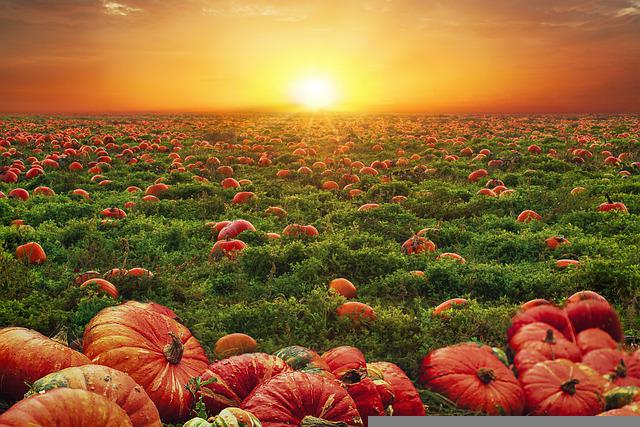When Are Pumpkins Harvested?

According to experts in the field, the best day to pick your squash is a dry, sunny one. If the vines are in good health and have not been affected by mildew, insects, or frost, this should be done at the end of August and continues until October. The trick is to pick your pumpkins before the first hard frosts and temperatures drop below freezing.
Most mid-sized pumpkins grown in Minnesota take between 90 and 105 days from planting to maturity and are ready for harvest. When it comes to growing miniature pumpkins, the process is quicker. Pumpkins were planted from June 1 to June 14 this year across much of the state. That means that pumpkins are at their peak of ripeness right now.
Count the days since you planted your garden pumpkin seeds to see if they’re ready to harvest. Subtract seven days from your count if you used seedlings instead of transplants.
Additionally, the pumpkin’s stem has hardened, indicating that harvest is imminent. But some varieties turn yellow or orange before they’re fully ripe, which can be an indicator. On the other hand, Fruit color is not a reliable indicator of how long it has been since the plants were planted.
However, this does not imply that they are ready to be harvested in the summer. Even though your pumpkins may appear to be fully grown, you’ll need to wait for the right time to harvest them.
Table of Contents
Signs It’s Time to Harvest Your Pumpkin
Seasonal Changes and Leaf Health
Harvest time is usually heralded by the onset of cooler weather and shorter daylight hours. It’s best to leave your pumpkins on their vines if frost isn’t expected in the forecast.
As long as the vines and leaves are healthy, they will grow. However, disease or insects can cause leaves to die. Affected pumpkins should be harvested because there are no leaves to nourish and grow.
Color and Firmness
First, you should check the pumpkin’s rind (also known as the skin).
There are numerous kinds of pumpkins to choose from, so you’ll want to make sure each is fully colored before carving it. With regard to Halloween-themed pumpkins, you’ll want to grow them in a bright orange hue. Other types, such as Baby Boos and Luminas, can have a white or off-white appearance when fully ripened.
Additional checks should be made on whether the rind is firm enough. If pressing your fingernail (or another object) into the rind results in an indentation or piercing of the skin, the pumpkin isn’t ready yet.
Attempting to pick your pumpkins before they’ve gotten firm enough can cause them to quickly shrivel up (sometimes within a day or two). Your firmness test may need to be done somewhere other than the front of your pumpkin if you’re worried about leaving marks on its pristine surface.
Pumpkin’s Vine and Stem
It’s important to inspect the pumpkin’s stem and vine in addition to the outer rind. It’s time to harvest if the vines begin to dry out and separate from the stem, which can shrivel, twist, and become even drier. This is another sign.
Be aware that the stem and vine are not required to be checked. Color and firmness alone are enough to tell if your pumpkins are ready to be harvested.
Hard Frost
Pumpkins, for example, can withstand a brief period of frost without harming themselves. You may want to harvest your pumpkins before the hard frost sets in for four hours when the temperature drops below 28 degrees.
Even though your pumpkins aren’t yet fully colored and firm, you shouldn’t be afraid to pick them if a hard frost threatens their survival and shortens their storage time.
When a pumpkin’s final, mature color has begun to emerge, it can still ripen while still on the vine. So, the best option is to let your pumpkin mature and fully grow on the vine naturally.
How to Pick Your Pumpkins
- It’s important to wear gardening gloves before harvesting to protect your hands from the vines.
- Cut the vine with a hand pruning tool (a sharp knife will also work) or a sharp saw. There is no need to worry about which side of the vine stem is being cut, but you should still leave the stem about 5-6 inches behind. Don’t be concerned if there are any extra vines, as they can be trimmed later.
- The stem is crucial to keep the pumpkin from decaying and rotting too quickly. Do not remove the stem from the pumpkin while doing this. Choosing to carry the pumpkin by its stem may result in this, so always avoid this.
- Many organisms can cause rotting, spoiling, and decaying pumpkins without the stem attached. Keep the stem attached if you want your pumpkin to stay healthy for as long as possible!

After Harvesting Your Pumpkins
After harvesting your pumpkins, you should pull them out of the ground to remove the vine. Many gardeners prefer to use vines as compost, which is a great way to reuse and recycle them. To be safe, only use vines that have not been affected by the disease (such as mildew).
When it comes to recycling, you can use either bag up the waste and throw it away or send it to a municipal composting center. Using these facilities, any fungus spores in compost will be destroyed.
Keep an eye on the Minneopa Orchards blog for more information on growing and harvesting pumpkins. This is a must-attend event with Halloween and Thanksgiving just around the corner, not to mention the rest of the fall festivities.
